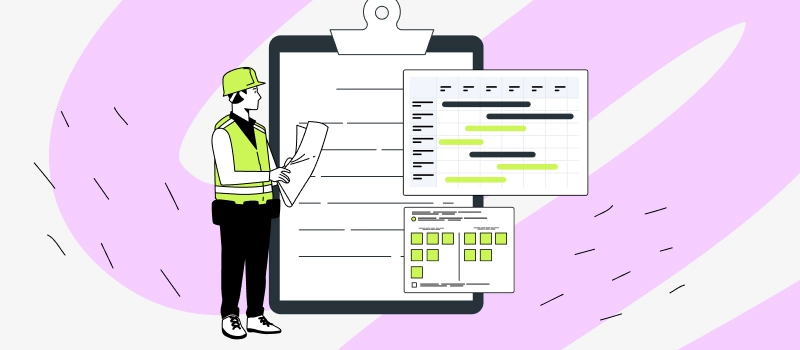
Construction project managers face a host of challenges that can derail even the best-laid plans. From budget overruns to communication gaps, the path to successful project completion is fraught with obstacles.
Understanding these common challenges and equipping yourself with effective strategies can make all the difference. So, in this article, we will explore the top 5 construction project management challenges and provide actionable insights on how to overcome them, ensuring your projects not only meet expectations but also thrive in a competitive industry.
1. Cost Overruns
Cost overruns can quickly turn any dream build into a financial nightmare. In fact, data suggests that large projects tend to go over budget by as much as 80%.
Unexpected expenses can derail timelines and leave project managers scrambling to find funds to keep everything afloat. But what makes it even trickier is the ripple effect those cost overruns create – delays tied to budget issues can cause scheduling conflicts down the line, making stakeholders frustrated and resulting in legal battles.
Causes:
- Poor planning and estimation. It all starts here. If the initial plans lack detail or the estimates are overly optimistic, you’re setting up the project for financial woes from the get-go. Inaccurate assessments of material costs, labor time, or even overlooked project phases can lead to a budget spiraling out of control.
- Unexpected site conditions. You might think you know what’s beneath the surface, but construction sites are notoriously unpredictable. From hidden utility lines to unforeseen geological issues, surprises can add significant costs for additional work and changes in design.
- Regulatory changes. Navigating through building codes and regulations is tricky, and changes can pop up throughout a project. If new compliance requirements arise after you’ve started, it can mean extra costs for redesigning or retrofitting existing work.
- Inflation and market fluctuations. Let’s face it – markets change. Prices for materials can fluctuate wildly due to supply chain disruptions or demand surges, especially in a booming economy. Keeping an eye on market trends is essential to avoid shocks down the road.
Solutions:
Step 1: Identify Potential Risks
Start by brainstorming what could go wrong. This could range from weather disruptions to supply chain issues or even unexpected site conditions. Gather your team for a brainstorming session – those diverse perspectives often unveil risks you might miss alone.
Step 2: Analyze Risks
Once you’ve got a list, it’s time to evaluate the likelihood and impact of each risk. Is there a slight chance of an issue that could derail the project or a high probability that it might cause serious delays? Create a risk matrix to map these out – use our free risk assessment templates to make it easier for yourself.
Step 3: Quantify the Costs
Now that you’ve got a handle on potential risks, think about their financial implications. For each identified risk, estimate the potential costs and how they tie into your overall budget. Don’t just focus on direct costs – consider indirect impacts, too (like delayed timelines leading to increased labor costs).
Step 4: Create a Contingency Plan
Prepare for the worst by creating contingency plans. This doesn’t mean you have to throw your budget out the window – just allocate a percentage (around 10-20%) as a safety net for unforeseen circumstances. Think of it as your project’s insurance policy.
Pro tip:
When it comes to estimating construction projects and sidestepping those pesky cost overruns, actiTIME shines as a reliable ally.
As a multifunctional time tracking tool, it lets you set custom hourly pay rates for your entire team or each employee individually so you can easily keep tabs on staff-related expenses and get accurate cost projections right from the start.
actiTIME reports also make it easy to analyze your past projects, inform your estimation process, and craft more reliable plans moving forward.
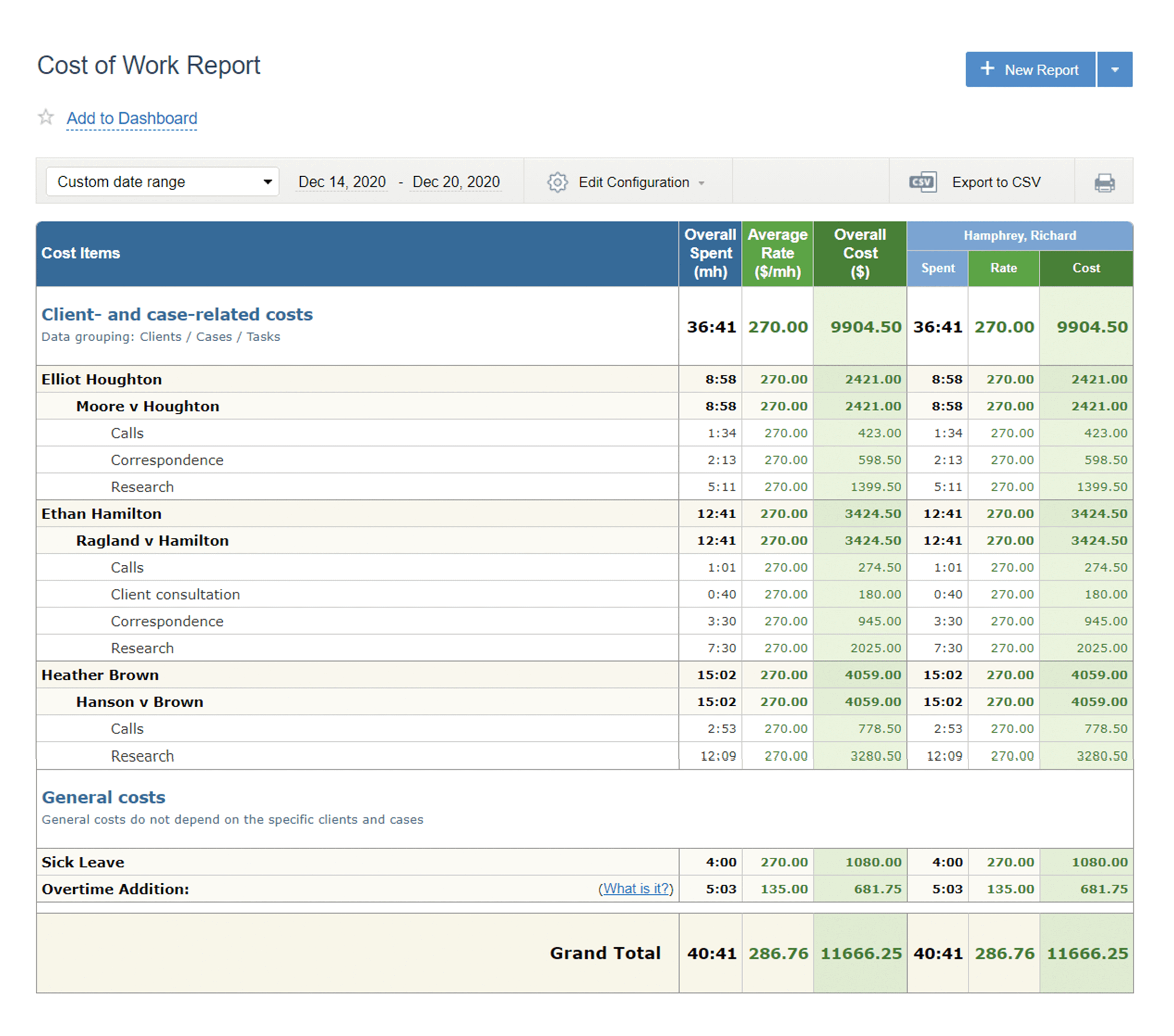
By combining real-time cost tracking with insightful analytics, actiTIME empowers you to stay on top of your budget and keep those overruns at bay.
Check actiTIME in action – sign up for a free trial here.
2. Project Delays
The 2022 survey by Cornerstone Projects revealed that 91% of construction businesses are involved in delayed projects, and most of those projects are delayed by 21-30% of the initial time estimate.
This data reveals a significant increase in construction project delays since the pre-pandemic times. This might be a result of the growing complexity and cost of modern projects that naturally extend project delivery over a longer time.
No matter the reasons, construction work delays often result in unexpected costs due to extended equipment rentals, overtime pay, or even penalties for late delivery. Plus, when one phase of the project stalls, it dominoes – tradespeople scheduled for subsequent tasks may require a reschedule, causing a chain reaction of setbacks.
Causes:
- Poor scheduling. One of the biggest culprits behind project delays is inadequate planning. When timelines aren’t carefully mapped out or if key milestones aren’t set, it often leads to chaos on-site. Without a well-thought-out schedule, tasks can overlap or be mismanaged, creating a domino effect on the entire project.
- Weather conditions. Weather is an unpredictable force. Rain, snow, or extreme heat can halt construction work. While we can’t control Mother Nature, we can anticipate her whims by factoring in seasonal changes during the planning phase to minimize these disruptions.
- Supply chain issues. Picture this: you’re all set to lay down some concrete, but the delivery truck is nowhere to be found! Delays in the supply chain due to shortages, shipping delays, or logistical hiccups can stall progress.
- Labor shortages. Finding skilled labor can be a challenge, especially in a booming construction market. If the right people aren’t available when you need them, this can lead to significant delays.
Solutions:
Step 1: Estimate Resources
Begin by breaking down your project into manageable tasks. Then, for each task, estimate the resources you’ll need – think materials, labor, and equipment.
Pay special attention to your time estimates. Here are some of the best estimation techniques you can try to figure out the duration of tasks and projects:
- Expert judgment. This technique involves consulting with engineers, project managers, and skilled tradespeople who have a wealth of experience. Leveraging the insights of seasoned professionals can provide a more nuanced understanding of the time frames involved. Their intuition can help illuminate potential obstacles and build more realistic timelines.
- Analogous estimating. This simple yet effective method looks at past projects to guide current ones. By comparing similar construction projects and their timelines, you can predict the time required for your current venture. It’s like using a playbook that provides benchmarks and insights for the present task.
- Parametric estimating. This technique also takes historical data and uses it to create a statistical model. For instance, if you know that building a certain type of structure typically takes a specific number of hours per square foot, you can use that to estimate your current project’s timeline based on its square footage.

Run actiTIME reports to get detailed historical data on the use of time in previous projects and estimate your future endeavors more accurately.
Step 2: Allocate Resources and Schedule Them Wisely
With your estimates in hand, it’s time to allocate resources effectively. Match the right people and equipment to the right tasks. Map out when each task will commence and finish and make sure they stack up nicely – if you’ve got a skilled carpenter, he should be working on the frame, not waiting around for concrete to cure.
Be realistic about timelines – allow for set-up and potential hang-ups. Incorporate buffer time between tasks so that if one drags on, it doesn’t hold up the next.
Visual tools like Gantt charts can make this step a lot more straightforward and visually appealing.

Organize your projects, set deadlines, and allocate tasks to employees in an easy way with actiTIME.
Step 3: Track Ongoing Work Progress
Staying on top of ongoing work progress is crucial for avoiding delays and keeping everything within budget.
That’s where actiTIME comes in – it offers intuitive time tracking functionality that makes monitoring your team’s productivity a breeze.
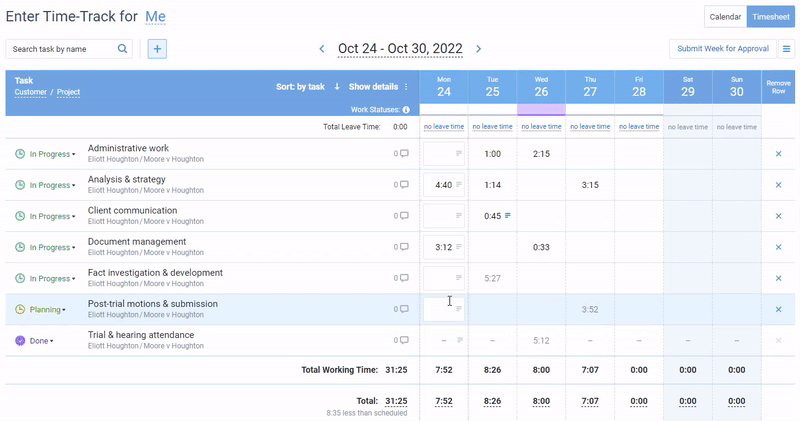
With online timesheets, team members can quickly log their hours, ensuring that no work goes unrecorded. Plus, the mobile app means you can keep track of progress right from the job site – no more waiting until the end of the day to submit timesheets!

Visual progress bars provide a clear snapshot of how much work has been completed versus the assigned task estimates. You can also set task deadlines and priorities or receive automated notifications when the risk of budget/estimate overrun comes up – this lets you make proactive adjustments before small issues snowball into major delays.
3. Scope Creep
Scope creep blurs the original vision, leading to confusion and dissatisfaction on all sides.
It begins innocently enough – maybe a client decides they want an extra window, or they change their mind about the color of a feature. However, before you know it, those small changes snowball into major shifts in the project’s scope. Suddenly, timelines get stretched, budgets explode, and team morale takes a hit as everyone scrambles to keep up with the ever-evolving plan.
As a result, projects that should be wrapped up in weeks can drag on for months, leaving stakeholders frustrated and questioning the efficiency of the team.
Causes:
- Poorly defined scope. If the project scope isn’t clearly defined from the start, you’re setting yourself up for trouble. Vague descriptions or lack of detailed plans often lead to misunderstandings and assumptions, which can snowball into significant changes later.
- Client changes. Clients can change their minds. Maybe they see a trendy new design, or they realize their initial ideas aren’t quite working for them. While it’s natural for clients to want to tweak their vision, frequent changes can lead to a runaway scope that no one planned for.
- Ongoing design development. Sometimes, the design is still a work in progress even after construction has started. This continuous tweaking and refining can lead to extra tasks being added to the original project scope, which disrupts timelines and budgets.
- Stakeholder influence. Involving multiple stakeholders can open the door to differing opinions and desires. As new voices come into play, requests for changes and additions are likely to arise, complicating the project even further.
Solutions:
Step 1: Clearly Define the Scope
Start off on the right foot by laying out the project’s objectives, deliverables, and timelines. Document everything in detail to avoid miscommunication down the road.
Use our free project plan template to map it all out!
Step 2: Engage Stakeholders Early
Invite all parties involved – clients, contractors, and suppliers – to discuss the project’s scope from the get-go. Their insights can help refine your plan and set realistic expectations.
Step 3: Establish a Change Management Process
Life happens – changes are inevitable. By instituting a formal process for handling requests for changes, you can manage the impact on the budget and schedule without losing your footing.
Step 4: Monitor Progress
Keep an eye on the project’s progress against the original plan. Use actiTIME to track how your team is working, see whether the initial estimates and deadlines are met, and identify any deviations right away.
Then, if you find scope creep creeping in, don’t panic! Review the reasons behind it and adjust your plans as necessary. This might mean reassessing timelines, budgets, or even the team involved.
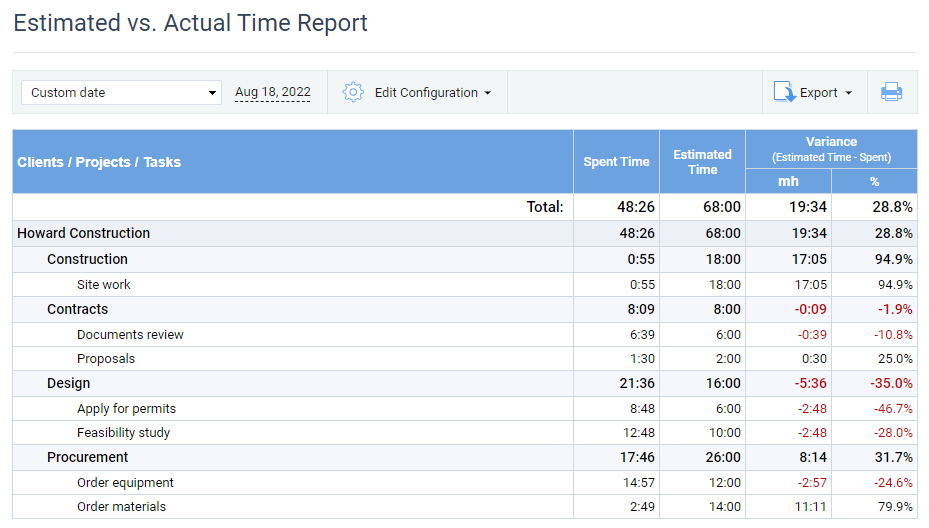
Analyze the use of time against the set estimates and monitor your team performance via actiTIME reports.
2. Communication Problems
According to PMI, communication problems are the #1 reason why most of the projects fail, and they can come in a variety of forms:
A contractor misinterprets the plans because the architect didn’t convey the details – suddenly, materials are ordered that don’t fit, or worse, the crew is on-site working with outdated information.
Such cases not only delay timelines but often lead to unexpected expenses as teams scramble to fix issues. Luckily, project managers can prevent communication problems by promoting a little more clarity.
Causes:
- Lack of clear objectives. When project goals are not clearly defined and communicated, it leads to confusion among team members. Everyone may have a different interpretation of what needs to be accomplished, resulting in misaligned efforts and wasted resources.
- Inadequate technology. Using outdated communication tools can hinder effective information sharing. Teams relying on paper-based systems or outdated software may struggle to stay in sync, while modern tools can streamline communication, making it easier to collaborate in real time.
- Diverse workforces. Construction sites often bring together a mix of people from different backgrounds and cultures. Language barriers and varying levels of technical jargon can lead to misunderstandings. Emphasizing inclusivity and providing language support can help bridge these gaps.
- High turnover rates. The construction industry is notorious for high employee turnover, and it often disrupts communication. When new hires are not fully briefed on project nuances, critical information falls through the cracks.
- Environmental distractions. The noisy and chaotic environment of a construction site can hinder face-to-face communication. Important conversations may go unheard, and critical messages can be lost.
- Poor leadership communication. When project leaders fail to communicate effectively, it creates a trickle-down effect of misinformation and distrust. Leaders should prioritize transparency, encouraging open lines of communication that keep everyone informed and engaged.
- Overlooking stakeholder input. Failing to include key stakeholders in the communication loop can create friction when decisions are made without their input.
Solutions:
Step 1: Establish Clear Lines of Communication
Right off the bat, designate a point person for each team. This reduces confusion about who to approach with questions or concerns. Ensure everyone knows their roles and responsibilities.
Use our free templates to document your project communication processes without a hitch.
Step 2: Utilize Technology
Invest in reliable communication tools – think walkie-talkies, project management software, or mobile apps designed specifically for the construction industry.
Using a collaboration platform like actiTIME, where everyone can access real-time project information and share updates or documents, makes a world of difference.
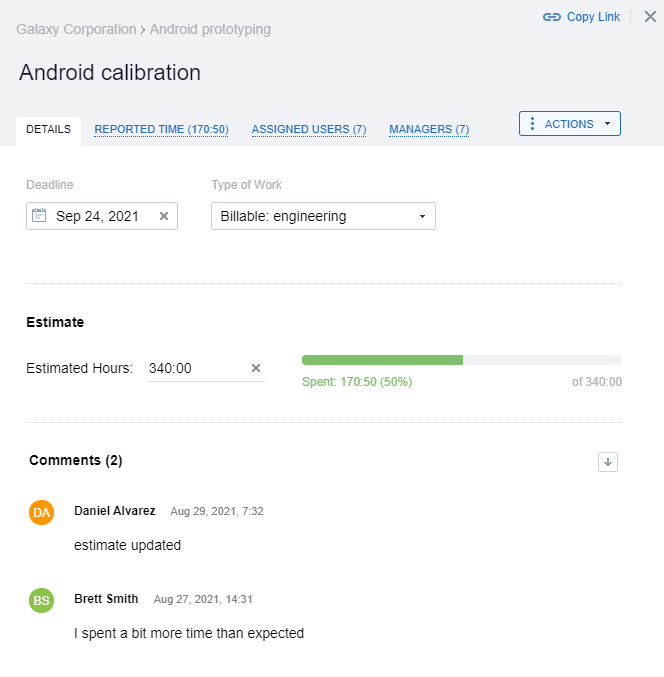
Share important work information with your team and keep everyone updated on performance progress using actiTIME.
Step 3: Provide Proper Onboarding for New Hires
Ensure that new hires receive comprehensive onboarding. This isn’t just about paperwork – it’s about immersing them in the company culture, processes, and project specifics. Make sure they understand their roles, who to go to with questions, and the importance of clear communication with their teams.
A buddy system can work wonders here – pair newbies with seasoned team members to guide them through the initial stages.
Step 4: Create an Inclusive Culture
It’s crucial to foster an inclusive culture where every worker feels valued and heard. Encourage open dialogue, where team members feel comfortable voicing their ideas and concerns.
Regular team meetings, feedback sessions, and social events can strengthen bonds among staff and promote a sense of belonging. When everyone feels included, communication naturally improves, leading to a more cohesive and efficient project workflow.
5. Admin Burdens
Picture this: a site buzzing with activity, equipment rumbling, and workers hustling, yet a mountain of paperwork looms overhead, threatening to thwart progress at every turn.
When project managers find themselves neck-deep in compliance forms, change orders, and endless approvals, it not only eats up valuable time but can also lead to significant delays.
Causes:
- Complex regulations. From zoning laws to environmental protections, every project must comply with an array of rules that often change. Keeping up with these regulations requires constant vigilance and an understanding of intricate legal language, which can be a significant drain on project time and resources.
- Data management issues. In construction, data reigns supreme – from project timelines and budgets to safety records and inspections. However, managing this data can become unwieldy. Whether it’s relying on outdated spreadsheets or juggling multiple software platforms, disorganized data management can lead to errors and oversight, creating additional layers of administrative overhead.
- Change orders. Changes are a part of life, but in construction, they can disrupt the flow like a pebble in your shoe. Whether they stem from client requests or unexpected site conditions, change orders can complicate the project. Each change requires thorough documentation, negotiation, and sometimes, re-evaluation of timelines and budgets, all of which add to the admin burden.
- Resource allocation. Efficiently managing resources – labor, materials, and equipment – can be a juggling act. Poor allocation not only leads to waste but also requires more time spent on planning and adjustments. Keeping track of who is doing what, where supplies are, and when equipment is available, often feeds into a cycle of administrative fatigue.
Solutions:
Step 1: Standardize Processes
Create standard operating procedures (SOPs) for common tasks. Whether it’s handling permits, managing change orders, or scheduling inspections, having a clear process can prevent mistakes and reduce confusion.
Check out this guide on how to optimize your workflows with ease.
Step 2: Delegate Wisely
Identify team members with strengths in specific areas – such as finance or compliance – and empower them to take ownership of those aspects. This not only distributes the workload but also fosters accountability.
Step 3: Embrace Technology
actiTIME is here to lighten that administrative load like a trusty hard hat on a rainy site. Here’s how it can help:
- Leave tracking. You can easily monitor who’s on the job and who’s not, and plan team workflows without a hitch.
- Overtime tracking. actiTIME makes it seamless to record any additional hours worked, ensuring that your team’s efforts are accurately billed and compensated.
- Cost tracking. You can see where your budget is going in real time, making it easier to keep projects on track and under budget.
- Automatic notifications. actiTIME will nudge you and your team when it’s time to submit hours or when a budget overrun is approaching, so nothing slips through the cracks.
- Integrations. actiTIME integrates smoothly with other tools you might already be using. It ensures that all your project data travels safely from one platform to another without much effort on your part.
Ready to easily overcome your construction project management challenges?
Sign up for a free actiTIME trial today.



















































